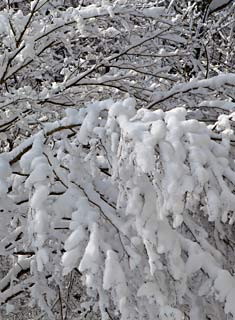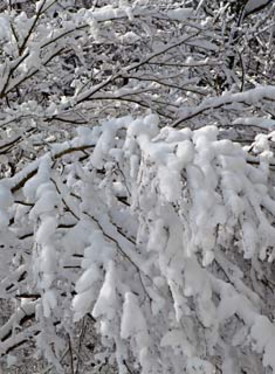 When Mother Nature prunes she does it badly. Her pruning shears are wind, rain, fire and snow. And after this winter, we sure do know snow! The damage will be extensive.
When Mother Nature prunes she does it badly. Her pruning shears are wind, rain, fire and snow. And after this winter, we sure do know snow! The damage will be extensive.
HERE ARE SOME TIPS about what to look for and what to do.
1. Don’t touch any plants when they are frozen or the temperature is much below about 40 degrees. Frozen branches are too fragile, like crystal, and they break easily.
2. As the snow melts, it pulls branches and bushes lower and lower. They bend and can snap off. To free them, try to break up the snow below them that’s pulling them down. Don’t pull on the branches or try to shake them free.
3. When they finally are free of snow and ice, they will not spring upright immediately. Be patient. Give them time. Their internal chemistry has to readjust.
As the season warms up, they will begin to come upright. But slowly.
4. After a few warm weeks, bushes can be gently straightened and staked. Old, soft, plastic-covered electronic wires make good tie-ups.
Ditto on bent over trees. Regular wire is sharp and cuts tree bark. Where it touches and pulls on a tree, cover it with a piece of old cut hose to protect the tree trunk.
5. Wait until late May, even June to do necessary corrective pruning. Let the spring shrubs and trees flower first. (Azaleas, rhododendron, flowering trees) But buds that were not killed by the harsh cold will be late and very slow to sprout.
6. What to prune in early spring. Only branches and twigs that are completely broken off. Also straighten shrubs and trees that are in the way, or blocking walks, driveways and doors.
About all that salt and other ice melting chemicals. The damage on plants shows as brown where it should be green. Especially grass and leaves. Bud damage occurs too.
As the snow melts, its water will carry much of the chemicals away. Even more can be removed with water from a hose or setting up a sprinkler.
NOW FOR SOME GOOD NEWS. The snow cover will have protected all perennials and the lower 2 feet of shrubs. These will have a very good year. Also new plantings.
The bottom line is to take a deep breath and give the garden until after May , or even late June, to recover, and then decide what to do to correct this winter’s damage. For there will be damage from Mother Nature’s messy pruning shears.
Ruth S. Foster is a landscape consultant and arborist. More gardening information can be found on her website: www.mothersgarden.net.
style=”display:block”
data-ad-client=”ca-pub-7337973401350193″
data-ad-slot=”3627905447″
data-ad-format=”auto”>
Credit: Ruth S. Foster




























